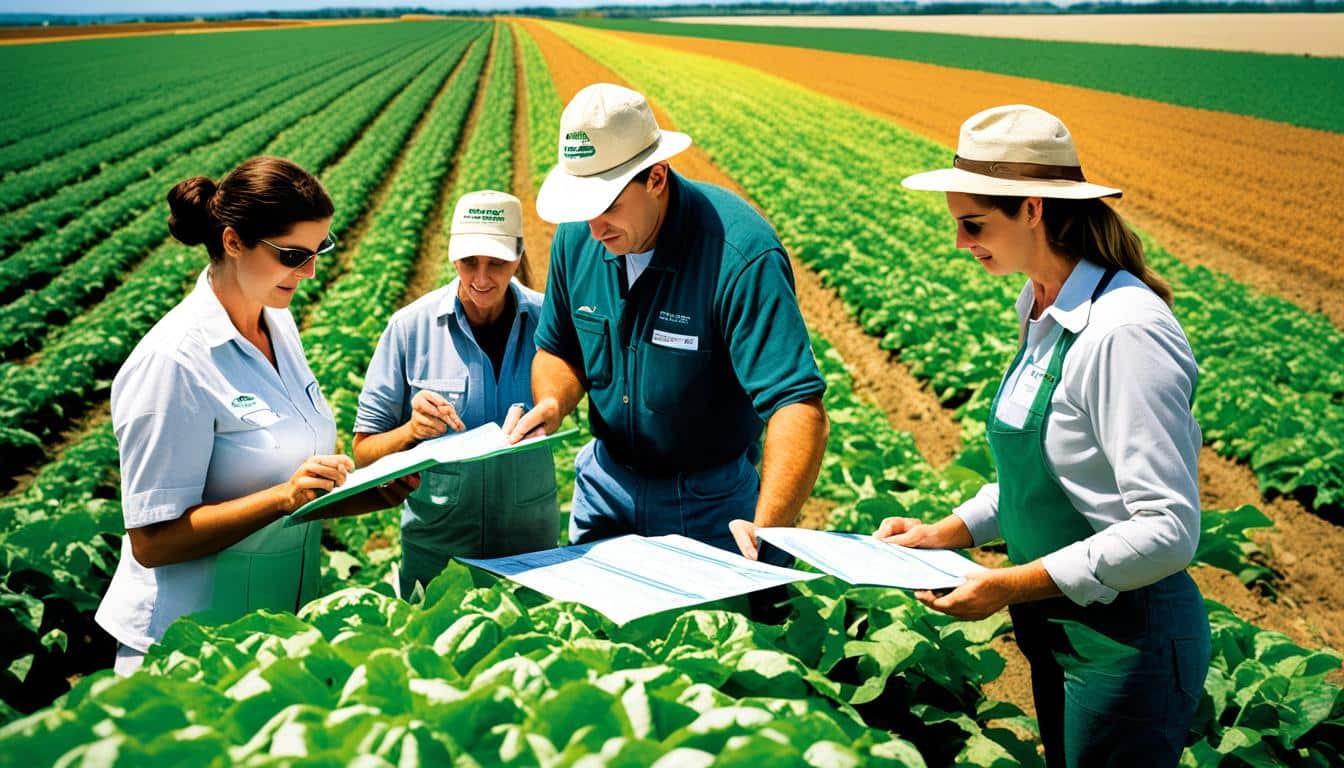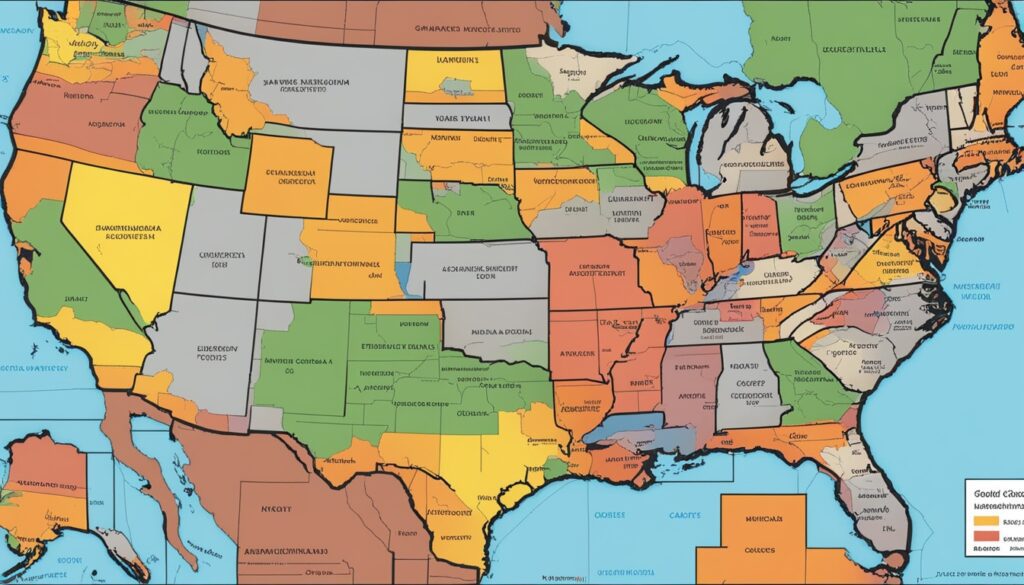Menu

Did you know that the guide for Organic Farming Compliance was last updated in 2005? It’s still a key resource for many in the West. It provides vital info on the best organic practices and materials. Farmers in the Western region work hard to balance making money with taking care of the environment. This balance is made easier thanks to keeping good farm records.
FCS Insights gives farmers essential data and advice for their farms. FCS stays neutral, ensuring their advice is all about what the farm needs. Their aim is to help farms be not just profitable, but sustainable in the long run. This focus improves how farms operate and lowers their impact on the world.
Today, understanding and following agricultural compliance policies is key. It ensures the food supply chain’s safety and sustainability. These policies include food safety, animal welfare, environmental rules, and labour laws. Keeping up with them helps farm owners meet high standards and stay legal.
Compliance in farming covers many areas. It looks at rules by important bodies like the FDA (under the FSMA) in the USA. The FSMA ensures fruits and vegetables are grown, harvested, and handled safely. These steps are vital for keeping our food safe and healthy.
In farming, several authorities ensure rules are followed to maintain quality. The USDA and EPA are significant. The USDA oversees organic farming, ensures animal welfare, and food labelling. The EPA looks after the environment, water and air quality, pesticide use, and waste.
Small farms may find it hard to keep up with all the rules. They often lack resources and knowledge. Educating them through workshops and expert advice is crucial. Tools like calendars and checklists also help ease the burden of following rules.
Following compliance boosts food safety and cuts legal risks. It also makes farms run better and improves ties with stakeholders. Farm management software from companies like Bivatec Ltd makes it easier to meet strict rules in agriculture.
In the world of farming, following rules is key. Compliance regulations are at the heart of good and safe farming. They make sure farmers look after the land, help the farming business stay strong, and keep food safe for us all.
Keeping our land and air clean is a must for farmers. In California, a special program checks farms to see if they’re following the rules. It’s teaching them to be kind to the environment. And, these efforts make farm products safer and better for everyone.
This push for better farm care helps cut farms’ bad effects on nature. It shows how learning about eco-friendly farming before making strict rules can work. The goal is for all farmers to keep their farms safe and green.

The financial health of farms is also very important. By setting up rules that make sense, everyone can win. Farmers are able to do better, plus their products are safer. Big or small, most farms must follow these important rules.
Changes are coming to these rules. They will make sure farm products are labeled clearly and any issues are dealt with fairly. These new plans help not just one farmer but all in the business. They aim to make farming stronger and better for us all.
| Program | Focus | Benefits |
|---|---|---|
| Produce Safety Program | On-farm inspections for compliance with Produce Safety Rule | Enhanced environmental health in farming, safe produce |
| Fertilizng Materials Inspection Program | Transparency in labeling, registration, product sampling | Improved consumer protection, enforcement mechanisms |
| California Organic Program | Alignment with National Organic Program regulations | Boost in consumer confidence, regulated organic growth |
To make sure farms follow rules properly, a detailed plan must be made. First, it’s key to look at what’s already being done and compare it to farm rules. This helps spot where changes are needed. Understanding laws like the Clean Water Act is vital. This check helps to know what needs to be fixed and how to make things better.
Taking a hard look at the current farming methods is step one. It’s about checking if the farm meets the rules of the agricultural industry compliance guidelines. This review is important to see what’s right and what needs work. It paves the way for a plan that’s just right for the farm.
After the first review, it’s time to build the compliance plan. This plan must be custom-made for the farm. It should include special actions, such as:
By following these ideas, farm owners can put together a good compliance plan development that does well with the law and business. This method makes it easy to move towards full agreement. It supports the farm’s success and helps take care of the environment while farming.
For any farm to do well, following agricultural laws is critical. The FDA Food Safety Modernization Act (FSMA) is key, with its focus on safe food from field to table. It makes sure farms stick to strict rules on the environment, worker knowledge, and cleanliness.

Knowing the rules of the USDA is also vital. This includes regulations like the Grain Inspection, Packers, and Stockyards ones. They lay down how grains and oilseeds should be marketed. And they ensure grains for export pass quality tests.
The USDA also protects animals and plants, supporting farm health and exports. It enforces the Animal Welfare Act. Meeting these rules means less trouble in international trade and upholding global agricultural standards.
The USDA Directives help with all the department’s rules and updates. Their online system is a great resource. It gives guidance on insurance to stop misuse and keep the system honest.
People can have a say in these rules through Regulations.gov. They can read and comment on proposed rules. This way, the rules meet the needs of all involved.
The USDA works with many groups to check that products meet quality standards. This partnership ensures that products are safe and effective. Compliance is vital for everyone who handles agricultural items.
Staying updated on laws like the FSMA is key for any farm. They protect people and help farms grow sustainably. Using these rules right benefits both the public and the agricultural economy.
In farming, many rules are hard to follow. It’s not just about knowing the law. Farmers also deal with money and how to run their farms while following the rules.
Understanding the laws in farming is a big issue. Rules, such as the FSMA’s Produce Safety Rule, have hard words. They talk about testing water from different sources differently.
Farmers might need help to understand these laws. They could get someone to explain the rules to them. This helps them follow the laws well.
Money problems are another big challenge. Making farms safer doesn’t always cost a lot. But, doing many safety things can add up quickly.
There are some help programs, like the USDA’s GroupGAP program, to make safety easier and cheaper. But, getting enough money is still hard for many farmers.
Still, there is help available. Online tools, like the On-Farm Food Safety Project, can make manuals for free. This helps farmers meet safety standards. There’s also training available from groups like the Produce Safety Alliance. They want to help farmers learn about the laws.
But knowing the laws and finding money are still big problems. Farmers are working hard to deal with these challenges. They want to follow the many rules correctly.

Over 20 years, FCS has forged strong bonds with farmers. This proves their trust and expertise in complying with agricultural laws. They don’t just push products. Instead, they give honest, info-backed advice that fits each farm’s needs perfectly. This personal touch makes their compliance support in agriculture top-notch, aiming for long-term sustainability.
At FCS, they focus on creating farm-specific ways to keep records. It’s all about accurate, deep data analysis to help farmers follow the laws smartly. They pull in advice from experts in farming, planning, and crunching data. FCS’s help is not limited by state lines, showing they can handle different rules. This points to their broad expertise and reach.
The insights from FCS really pay off. Their detailed, data-driven reports not only save money but also boost how farms work. These insights also open doors to grants, showing FCS works hard to get funds for farmers. Their methods make sure farming meets laws while supporting economic sustainability and the environment. They show a real dedication to lasting, stable farming methods.
| Key Areas | FCS Focus |
|---|---|
| Data Analysis | Tailored, farm-specific insights |
| Funding Support | Access to various grants |
| Expertise | Agronomists, planners, data analysts |
| Geography | Operates in multiple states |
| Sustainability | Focus on economic and environmental health |
FCS doesn’t just ensure compliance. They lift the game for farming’s sustainability and profit. Their full-on method makes FCS a key partner for farmers wanting to follow rules without sacrificing their business’s or nature’s health.
The world of agricultural compliance can seem complex. My goal is to make it easier. I aim to guide you through essential farm policy rules. This helps ensure you follow agriculture regulations.
The USDA provides a wealth of information online. Here you can find everything from rules to guides. This platform, like Regulations.gov, lets farmers learn and stay compliant easily.
The USDA gives farmers access to critical laws and regulations. These rules cover everything from food distribution to rural services. They also set standards for grains and oils, and monitor meat from the farm to the table.
These rules are crucial for keeping our agriculture safe. They help reduce trade roadblocks. Thanks to these efforts, our agriculture can grow strong and follow the rules.
For organic farming, the National Organic Program (NOP) Rule is key. It lists allowed farming techniques and materials. Organic farmers need to follow strict rules, from what their livestock eats to how manure is used. This ensures the focus stays on sustainable and healthy farming.
For those moving towards organic farming, the USDA’s SARE programme is very helpful. It provides tips and case studies on how to switch. This can bring economic benefits and make the farm more successful in the future.
| Compliance Area | Key USDA Support |
|---|---|
| Food Distribution Programs | USDA links to Federal Regulations and public laws |
| Rural Utility Services | Ensures compliance with Federal regulations and policies |
| Meat Production | Official marketing standards and regulatory oversight |
| Animal Welfare | Administration of the Animal Welfare Act |
| Organic Farming | National Organic Program guidelines and SARE insights |
Following this guide to agricultural compliance is key for farmers. It helps you understand and follow the many rules. By doing so, you ensure your farm meets all policy needs.
On-Farm Compliance Reviews are key for farmers to check if they meet rules. Before formal checks, farmers get a chance to match their ways with set rules. This helps them be ready for when the officials come. They get tips and help from experts. This improves how they work and reduces risks.

They are checks done on farms to see if they follow rules like those by the FDA’s FSMA. Farmers get feedback on how to do better. The OFRR programme has visited farms like Willis Family farm in Oregon and the Jackson Farming Company in North Carolina. These visits help farmers find and fix any issues early, making them more ready for official checks.
To get ready, farmers first need to look at their own work and want to do better. They can learn in a Produce Safety Alliance course about the FSMA Produce Safety Rule. This lets them find out what’s most important. Farmers should listen to the advice from reviews and use it in their daily work. This helps them change smoothly when officials come.
Doing reviews helps farms be safer and work better. The tips from these checks can help farm life improve. States help with the money for these reviews because they believe rules are vital.
This table shows how following conservation rules has helped over the years:
| Year | Compliance Achievements | Benefits |
|---|---|---|
| 1982-1997 | 40% reduction in annual cropland soil erosion | Preserved soil health and increased long-term productivity |
| 2001 | 98.0% of tracts and 98.9% of acres meeting compliance | Validation of effective compliance practices |
| Fiscal Years 2012-2015 | Omitted random sample checks and data processing errors | Highlighted need for improved compliance procedures |
Compliance reviews help farmers follow rules better. This leads to not just legal but also more sustainable farming.
Today, technology is crucial in ensuring farms follow the rules. Innovations like precision agriculture, sensors, and drones are changing how farms meet rules. They help farms work better and more sustainably.
Precision agriculture leads the way in new farm tech. It lets farmers use tools and software to manage resources like water precisely. This strategy increases yields while reducing harm to the environment, which meets rules. It helps farms cut down on waste, which is good for rules like the Clean Water Act (CWA) and the Clean Air Act (CAA).
Sensors and drones in farming make watching and collecting data better. They give immediate details on soil health, crops, and water. This helps farmers spot and fix issues fast. It supports many regulations, such as the Federal Insecticide, Fungicide, and Rodenticide Act (FIFRA) and the Resource Conservation and Recovery Act (RCRA). These tools make following rules easier and help farms run better.
By using this new tech, farms can meet rules while farming more sustainably and efficiently. Bringing together precision agriculture, sensors, and drones is a big step forward. It shows a future for agriculture that’s more ready and follows rules well.
Funding is key for farms to meet rules, use green ways, and be ready for laws. Government grants and private funds are vital here.

Government grants help farms with green compliance and eco-friendly actions. The America the Beautiful Challenge (ATBC) plans to give about $119 million. This is for projects to protect and heal lands, like rivers and wetlands, to make them stronger against climate issues.
The ATBC does a lot, from saving at-risk plants and animals to letting more people enjoy nature. It helps local and Tribal areas, and it uses wisdom from Indigenous people. This all adds to more jobs and growth in the community.
Private funds are big help too, reducing the costs for farms. They come from groups or businesses that care about eco-friendly farming.
See the table below for a look at different funds available:
| Funding Source | Purpose | Average Grant Amount | Key Features |
|---|---|---|---|
| America the Beautiful Challenge (ATBC) | Conservation and restoration | $119 million (total) | Focus on ecosystem resilience and community engagement |
| Farm Vitality Planning Grant | Farm planning and sustainability | $7,500 | Emphasises energy-saving measures |
| Resilient Food Systems Infrastructure Program | Strengthening food systems | $10,000-$100,000 | Supports various aspects of food resilience |
| Private Investment Funds | General compliance initiatives | Varies | Flexible funding for innovation and expansion |
With these opportunities, farms can improve compliance, try new ideas, and go greener. It’s vital to know about these funds. They help farming last longer and keep the land healthy.
Studying farm compliance success helps us see how guidelines work in the real world. Let’s look at a Michigan farm’s compliance journey and a New York farm’s use of FCS services. These examples show how farms benefit from following compliance rules.
Mark and Amy Magura turned 200 acres in Starke County, Indiana, into a vibrant wetland and wildlife area over three years. Their work not only meets Michigan’s compliance goals but also boosts ecological health. By taking proactive steps, they made a huge difference.
Bill Cooper made big improvements on his Wythe County, Virginia, farm using CREP and Virginia’s BMP Program. His farm now has over 13,000 feet of new fencing and 7,000 feet of pipeline. This shows how New York farm FCS services help farms grow and meet compliance standards.
Christopher Sumpter Jr. from Borden, South Carolina, and Justin Knopf from Gypsum, Kansas, stand out for their work too. Sumpter manages cattle and takes part in the CRP. Knopf Farms is known for using sustainable practices to grow many crops. These farmers show how different approaches can lead to success.
For more stories and tips, visit the agricultural compliance success stories page. There you can learn how to apply compliance measures for your farm’s benefit.
To be successful, it’s vital for farmers to understand the unique agricultural regulations of each state. For example, Michigan and New York have their own farming laws. These laws consider the different environments, economies, and communities within the state.

In Michigan, farming laws cover many areas of farm operations. The state has rules on how to protect the soil and water, the right use of pesticides, and ensuring crop insurance. The aim is to promote farming that is good for the environment and the farm’s long-term success.
New York focuses on strict rules to safeguard the environment and health. These involve getting certifications for organic farming, upholding animal welfare, and managing waste properly. Compliance with these standards is done through careful environmental checks, like the NEPA, that ensure big projects are eco-friendly.
| State | Regulation Focus | Examples |
|---|---|---|
| Michigan | Soil Conservation, Water Quality | Farm loan consolidation, Building maintenance funding |
| New York | Organic Farming, Animal Welfare | Organic farming certification, Environmental assessments |
Each state caters its rules to suit its own farming scene. This helps farmers meet these state policies while supporting larger sustainability efforts. By knowing and following Michigan’s and New York’s specific agricultural rules, farmers can run better, greener farms.
Agricultural compliance policies are changing due to global trends on the rise. The APHIS service has done a lot to keep up with these changes. Through its work, 900 million acres of farmland have been safe over 50 years. It also helped move $177 billion in U.S. agriculture goods. This shows how important APHIS is for protecting the 21.6 million jobs in American agriculture.
Scientists at APHIS have looked ahead and found ten big trends. Security threats, climate change, and the need for new technology are among them. The challenges are getting bigger, calling for better monitoring and ways to reduce risks.
The future of farming rules will lean on data analytics more and more. This high-tech shift will make rules for farming more detailed. It will also respond to how people feel about taking care of animals and the wild. Governments will need to adjust their actions based on what the public wants.
Trust in government farming programmes is being tested by different issues like politics and money. This could slow down new farming rules from taking effect. So, it’s key to make policies that work for everyone. This will also help with fighting worldwide health problems, by joining forces internationally.
Farmers are being asked to use more green methods to fight pollution and cut down on harmful gases. More environmental-friendly farming is wanted. Companies are also using data to help farmers make better choices. Yet, this farming data is often kept separate by various agencies, which isn’t that helpful.
The way farming data is shared and used is another problem. If the USDA and researchers could easily share data, they could learn a lot more. This would help make farming rules better and help the environment. So, the farming industry needs to work on sharing and using data better.
Farming and following the rules can be a tough path. It requires understanding, adaptability, and looking ahead. Farmers must follow strict rules while keeping their land healthy and their business strong. The USDA found that following these rules has led to less erosion on farmlands.
Most land that easily erodes gets help from the government. The areas where rules have reduced erosion are mainly those getting financial aid. So, the efforts to make farmers follow these rules are working.
Soil erosion is decreasing, even on lands not so prone to it. This shows the wide and positive impact of following the rules set by Conservation Compliance. The use of better farming methods and adopting practices like conservation tillage quickly are all thanks to these rules.
Expanding these rules to prevent nutrient loss could give farming more wins for the environment. Farming areas with a lot of nutrient loss, often getting help from the government, could see big improvements. Rules about nutrient loss could be very important in some areas. They could help reduce nutrients entering the water. This would make farming better for the environment overall.
To wrap up, knowing about farming rules and using sustainable farming tactics are key. Adapting to new technologies and worldwide changes is also important. This makes sure farms stay within the rules, are good for the environment, and do well as businesses.
These rules make sure farming is safe, green, and follows the law. They are about protecting the environment, keeping food safe, and caring for workers.
The FDA is important for food safety thanks to the FSMA. They set smart rules to keep the food chain safe and green.
These rules are key for farming to go easy on the environment and keep the economy strong. They ensure farms last and bring profit for years.
First, check how your farm works and what laws it must follow. Then, create a plan that fits your farm, using data and checks to stay on top of things.
Know about the FSMA and how it sets high food safety standards. Being up to speed on laws and what they mean is key for every farm.
Hard parts include complex rules and limited money, especially for smaller farms. Getting help and finding extra funding can ease these struggles.
FCS gives advice based on solid facts through FCS Insights. This supports farms to do better, use resources well, and keep up with the rules in a green way.
These checks let farmers see where they stand with rules early on. They get tips and help, making sure they’re ready to meet rules and avoid trouble.
Precision tools and high-tech gear like sensors and drones help farms do more with less. They focus on what’s needed and help follow rules without losing productivity.
Yes, there’s help from government grants and private funders for farms following the rules. This cash can lower the costs of being green and compliant.
Stories from Michigan and New York show how farms can succeed with the right guidance. They tell about the hard work and the benefits of following the rules.
Definitely, each state has its own agriculture rules. Knowing these rules well is vital to meet all needed standards, both general and local.
Tomorrow’s rules will focus on global changes and new tech. The goal is to farm smarter, more efficiently, and in a way that helps the planet.